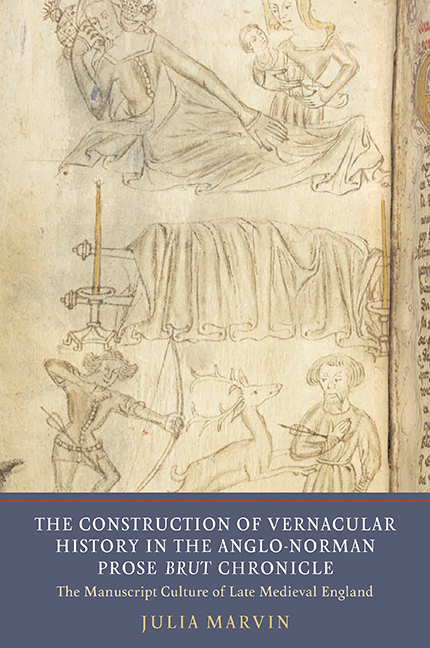 The Construction of Vernacular History in the Anglo-Norman Prose Brut Chronicle
The Construction of Vernacular History in the Anglo-Norman Prose Brut Chronicle from Part II - Reconstruction and Response
Published online by Cambridge University Press: 01 February 2018
Ordinatio (broadly speaking, the basic presentation and organization of a work), apparatus (elements provided to aid navigation and interpretation of the text), and annotation (by which I will mean marks made by users after a manuscript's initial production) are almost always attenuated or invisible in modern editions of medieval texts, but they are of course a fundamental part of the experience of reading in manuscript. Each of the major versions of the Anglo-Norman prose Brut has a characteristic ordinatio.
Although the manuscripts are far from uniform, all tend to be designed to have larger initials separating sections of text. Even this basic guidance was not so basic that it could not be foregone, since in many manuscripts the initials were never put in, and the reader navigates via blank spaces. The chronicle's fundamental organizing principle is the reign of a king, and for the many reigns that are briefly reported, the reign is also the basic narrative unit. When accounts of single reigns run longer – as with Brut, Arthur, and the kings from Edward the Confessor on, and especially in the continuations – the unmanageable length of the sections elicits a range of responses from bookmakers. Their choices about if and how to divide text within reigns reveals something about how they make sense of the narrative.
In the Oldest Version, four of the five surviving manuscripts have brief rubrics heading each section, usually identifying the king in question and perhaps mentioning an outstanding feature of his reign (see Plate 9). Among the manuscripts, these headings appear to be related to one another, but also to be adapted by individual rubricators to, for example, fit the space available. The majority of Short Version manuscripts have headings only at the beginning of the prologue and main text, if even then, the result being a set of manuscripts that are not easy to navigate without the addition of supplemental apparatus (see Plate 11).
To save this book to your Kindle, first ensure [email protected] is added to your Approved Personal Document E-mail List under your Personal Document Settings on the Manage Your Content and Devices page of your Amazon account. Then enter the ‘name’ part of your Kindle email address below. Find out more about saving to your Kindle.
Note you can select to save to either the @free.kindle.com or @kindle.com variations. ‘@free.kindle.com’ emails are free but can only be saved to your device when it is connected to wi-fi. ‘@kindle.com’ emails can be delivered even when you are not connected to wi-fi, but note that service fees apply.
Find out more about the Kindle Personal Document Service.
To save content items to your account, please confirm that you agree to abide by our usage policies. If this is the first time you use this feature, you will be asked to authorise Cambridge Core to connect with your account. Find out more about saving content to Dropbox.
To save content items to your account, please confirm that you agree to abide by our usage policies. If this is the first time you use this feature, you will be asked to authorise Cambridge Core to connect with your account. Find out more about saving content to Google Drive.